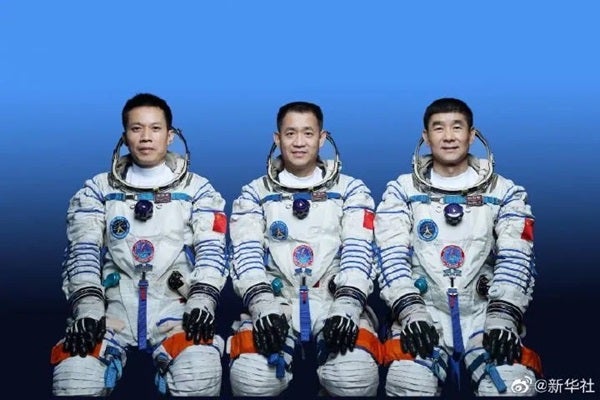Earth is on the cusp of gaining another orbiting laboratory.
Early Thursday morning, Beijing time, the China National Space Administration launched three astronauts to rendezvous with the core module of a new space station. This is the third launch of 11 missions planned to China’s space station — named Tiangong, meaning Heavenly Palace — before the end of next year.
The Shenzhou-12 spacecraft blasted off from the Jiuquan Satellite Launch Center in the Gobi Desert at 9:22 a.m. on June 17. Aboard the rocket were three astronauts: Nie Haisheng, Liu Boming, and Tang Hongbo. About six and a half hours later, at 3:54 p.m., Beijing time, they became the first Chinese astronauts — or taikonauts — to enter to enter the Tiangong space station via the Tianhe core model, which launched at the end of April.
Who are the crew?
While none of the crew was aboard China’s first manned space flight in 2003, Nie was a backup for the mission. He later joined the crews of two more Chinese missions: Shenzhou 6 in 2005 and Shenzhou 10 in 2013. At 56 years old, Nie is now the oldest taikonaut to venture to space.
Liu is also a veteran astronaut, having previous flown to space as part of the Shenzhou 7 mission in 2008. During that mission, another crew member preformed China’s first spacewalk, while Liu handed him a flag to wave for viewers — making Liu the second taikonaut to touch space.
Today’s flight is Tang’s first trip to space. However, since being selected to China’s astronaut program in 2010, he has been training for the opportunity.
Building history
Nie, Liu, and Tang will remain on board Tiangong for about three months to continue preparing the space station for full operations. Their work will mainly involve installing equipment and testing vital function like waste management and life support. They are also scheduled to conduct two spacewalks.
“This flight mission is the first manned mission to the space station under construction,” Nie said at a press conference before the flight. “We are challenged of course,” the astronaut said while reflecting on their ambitious list of tasks. “My colleagues, Liu Boming and Tang Hongbo, would certainly agree that we will work together to conquer those difficulties.”
Tiangong is expected to operate for at least a decade. Once built, the station will serve a similar role as the International Space Station, becoming an advanced orbiting laboratory for both China and partner countries. Already, nine of the planned experiments have international partners signed on. However, whether or not foreign astronauts will also join future taikonauts on the station is yet to be determined.
Considering China’s successful crewed launch today and the historic Zhurong Mars rover landing, the countries young space program is certainly living up to the ambitious plans it has set for itself.










